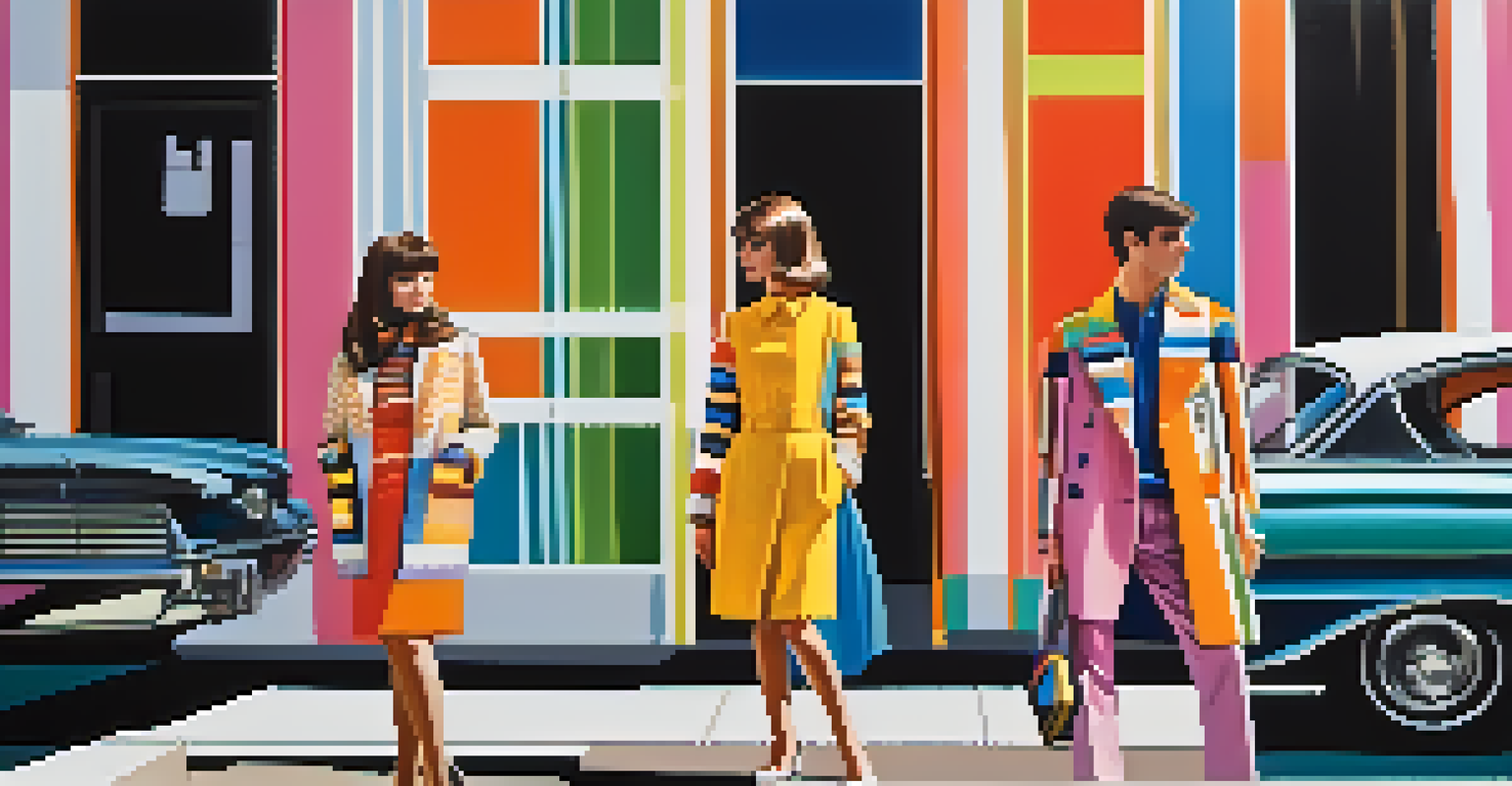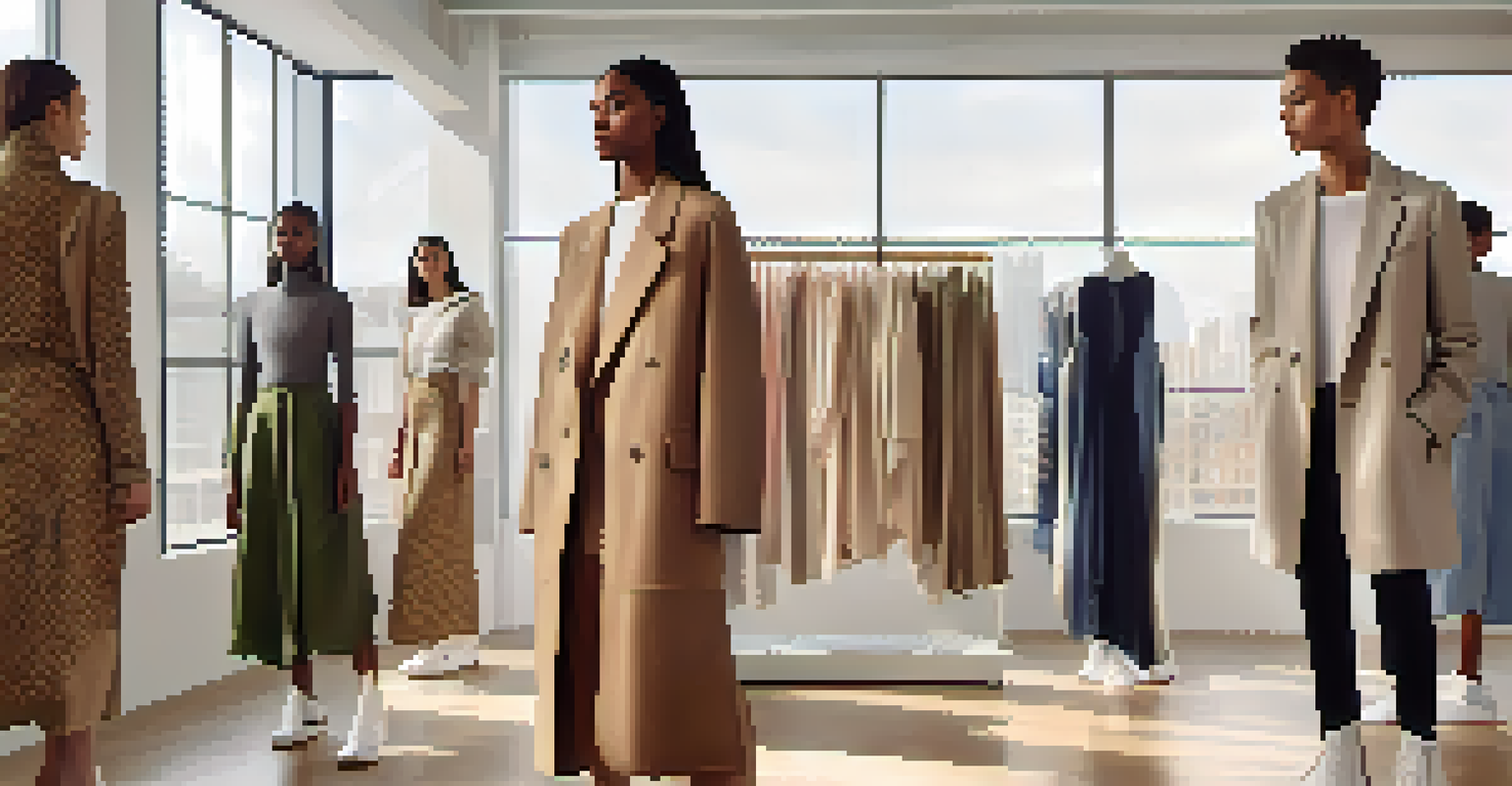Hollywood's Influence on Fashion Trends Through Iconic Films

The Golden Age: Hollywood Sets the Stage for Fashion
During Hollywood's Golden Age, films became a powerful medium for fashion. Icons like Audrey Hepburn and Marilyn Monroe not only captivated audiences with their performances but also set trends that defined an era. For instance, Hepburn's little black dress in 'Breakfast at Tiffany's' became a staple in women's wardrobes, showcasing how cinema can influence everyday fashion choices.
Fashion is the armor to survive the reality of everyday life.
This period marked the beginning of a symbiotic relationship between filmmakers and designers. Costume designers worked closely with fashion houses to create looks that would resonate on screen and off. These partnerships not only elevated the storytelling but also turned actors into fashion icons, whose styles were eagerly emulated by fans.
As films became more accessible, through television and later digital platforms, the impact of these fashion choices expanded. The allure of Hollywood glamour inspired countless trends, making it clear that what we see on screen can have a lasting effect on our own fashion decisions.
The 1960s: Breaking Norms with Bold Styles
The 1960s ushered in a wave of change, both socially and fashionably, with films reflecting this shift. Movies like 'The Graduate' showcased a laid-back, yet stylish aesthetic that resonated with the youth of the time. The iconic scene with Dustin Hoffman in his casual attire highlighted a departure from traditional fashion norms, encouraging people to embrace individuality.

This decade also saw the rise of the Mod fashion movement, heavily influenced by films. The bright colors, geometric patterns, and sleek silhouettes seen in movies captured the spirit of a generation eager to break free from the past. Fashion became a form of self-expression, with cinema leading the charge.
Hollywood Shapes Fashion Trends
From Audrey Hepburn's iconic dresses to modern sustainable fashion, cinema has consistently influenced and defined styles across different eras.
Moreover, celebrities began to leverage their film roles to launch or enhance their fashion careers. The line between Hollywood and the fashion industry blurred, as stars like Twiggy became synonymous with the Mod look, proving that films could create lasting fashion legacies.
The 1980s: Glamour and Excess in Film Fashion
The 1980s was a decade defined by excess, and this was reflected in the bold fashion choices seen in films. Movies like 'Flashdance' and 'Working Girl' introduced vibrant colors, oversized silhouettes, and an overall sense of daring that influenced everyday attire. The glamour of Hollywood inspired a generation to embrace extravagance in their wardrobes.
In the world of fashion, there is no such thing as a standard. You are what you wear.
Fashion designers began to create pieces specifically for films, knowing the potential for their designs to set trends. Iconic outfits, such as Jennifer Beals' leg warmers in 'Flashdance,' became symbols of the era, showcasing how cinema could dictate fashion norms. These styles not only defined the decade but also left an indelible mark on fashion history.
As music videos also emerged as a new visual medium, the interconnection between film and fashion deepened. Stars like Madonna and Prince influenced not just music but also the way people dressed, showing how the cinematic experience extended beyond the silver screen.
The 1990s: Grunge and Minimalism Take Center Stage
The 1990s brought a shift towards more relaxed and minimalist styles, largely influenced by films that resonated with the youth. Movies like 'Clueless' and 'Reality Bites' showcased a mix of grunge and preppy looks that defined casual fashion for a generation. The iconic yellow plaid outfit worn by Alicia Silverstone became an emblem of 90s fashion, blending film and everyday wear seamlessly.
This decade also saw the rise of 'anti-fashion' with films highlighting more rebellious, less polished looks. The influence of grunge was palpable, with movies like 'Singles' popularizing flannel shirts and combat boots. This shift demonstrated how film could challenge traditional beauty standards and promote authenticity in personal style.
Hollywood Influences Fashion Trends
Throughout various decades, films have played a crucial role in shaping fashion styles, from the little black dress of the 1950s to the bold statements of the 1980s.
Moreover, the 90s marked the beginning of the rise of streetwear, which has become a dominant force in fashion today. The blending of high fashion with everyday street style found its roots in the films of this era, showcasing how Hollywood can inspire and redefine what is considered fashionable.
The 2000s: A Blend of High Fashion and Pop Culture
The 2000s witnessed a fusion of high fashion and pop culture, with films like 'Sex and the City' redefining what it meant to be stylish. Carrie Bradshaw's eclectic wardrobe, filled with designer pieces and daring combinations, sparked a new wave of fashion exploration among viewers. The show and its film adaptations became a cultural phenomenon, showcasing how television and cinema could influence fashion choices.
This era also saw the rise of product placement, where fashion brands collaborated with filmmakers to showcase their designs on screen. This strategy not only elevated brand visibility but also allowed fashion trends to emerge directly from the films we loved. Iconic pieces, like the Manolo Blahnik shoes worn by Sarah Jessica Parker, became must-haves for fans.
As social media began to take off, the impact of film on fashion became even more pronounced. Viewers could instantly share and replicate looks, creating a new cycle of influence that blurred the lines between Hollywood and everyday life.
The 2010s: Diversity and Inclusivity in Fashion Choices
The 2010s marked a significant shift towards diversity and inclusivity in fashion, largely influenced by films that celebrated different cultures and body types. Movies like 'Black Panther' showcased stunning costumes that drew from African heritage, inspiring fashion trends that embraced cultural appreciation. This era demonstrated how films could be a platform for broader representation in the fashion industry.
Additionally, the rise of body positivity movements influenced both Hollywood and fashion brands to embrace a wider range of body types. This shift was reflected in films that featured diverse casts, encouraging viewers to celebrate their individuality. Fashion became less about fitting a mold and more about expressing one's unique identity.
Diversity and Inclusivity Rise
In the 2010s, films began celebrating diverse cultures and body types, influencing the fashion industry to embrace a broader range of representation.
Social media played a crucial role in amplifying these changes, allowing audiences to engage with fashion in new ways. Influencers, inspired by film styles, shared their takes on outfits, making fashion more accessible and relatable to the masses.
The 2020s: Sustainability and Fashion Forward Thinking
As we enter the 2020s, the conversation around sustainability in fashion has taken center stage, and films are reflecting this growing concern. Movies like 'The True Cost' have brought attention to the environmental impact of fast fashion, prompting audiences to rethink their purchasing habits. This shift highlights how cinema can not only inspire style but also promote ethical considerations in fashion.
Fashion designers are now collaborating with filmmakers to create sustainable collections that are both stylish and environmentally friendly. This collaboration is paving the way for a new generation of fashion that prioritizes quality and sustainability over mere trends. The styles seen in films today often reflect a commitment to responsible fashion practices.

Furthermore, the influence of streaming platforms has made it easier for diverse stories and styles to reach a global audience. As fashion continues to evolve, the connection between Hollywood and fashion remains strong, shaping trends for years to come while championing sustainability.